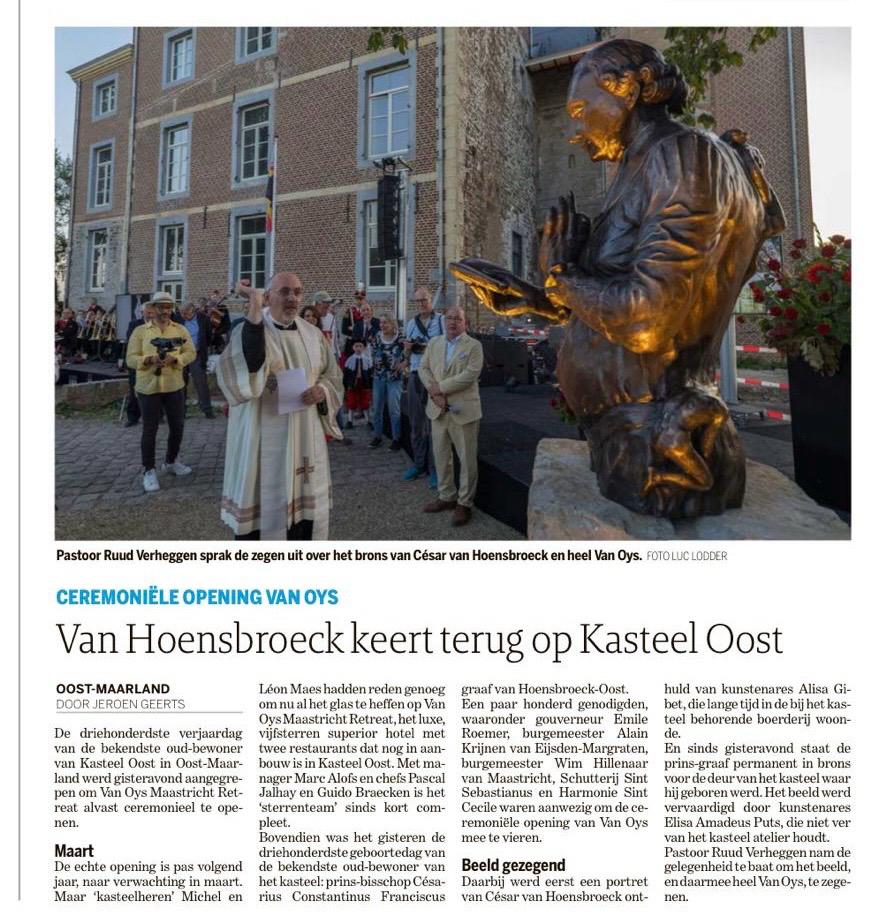More about the Prince-Bishop of Liege
Written by Joes Minus, Historian. Maastricht june 2025.
An statue of a human being
What is actually to be done with an statue of a human being? In our time, that question is perhaps more relevant than ever before. It seems so simple: you cast someone in bronze cut him out of stone, put him on a pedestal, and voila – this was someone important. Good for the country, for the city, or for those who like to associate themselves with the statue. But the context of such a statue is often as smeared as the material from which it is made. As if a single glance is enough to understand who someone was, and why that person should be remembered.
The truth is more whimsical. A person is never unambiguous, never just right or wrong, beautiful or ugly. Therefore, if an image is to represent anything, it should not just be a badge of honour. It must show who someone was – in all contradictions. Only then is an image a representation of a person.
Cesarius Constantinus Franciscus Count of Hoensbroeck-East was the last true Prince-Bishop of Liège. He was a figure who fitted perfectly into the field of tension that characterised the old principality: conservative and progressive, pious and authoritarian, powerful and at times very vulnerable.
The prince bishops of Liège – from Notger to our Cesarius – were political heavyweights for a thousand years. They ruled over a fragmented country with a colourful mix of languages and cultures, and knew how to play bigger powers against each other on the sly. Liege was not a corner of Europe, it was at the centre of it.
Among Cesarius’ predecessors were great princes, not always as pious as one would expect of a bishop. The first real prince-bishop was Notger, of whom it is said that Liège owed him to God, but everything else to Notger. He made Liège the Athens of the north, where scholars fell over each other during the early and high Middle Ages. Unlike ancient Athens, here women could also assert themselves, like Juliana of Cornillon. In large parts of the world, the Sacrament Day she devised in 1221 was a day off.
The prince-bishops were really not only concerned with religion. They also asserted themselves as secular rulers – and that with a capital full of people who wanted above all to stand up for themselves. In 1407, the people of Liège rebelled against the Prince-Bishop John of Bavaria, driving him out of the city. A year later, with the support of his German family, the bishop would recapture the city and had the leaders of the revolt executed in Maastricht and their bodies placed there on the city wall.
The principality became so rich and powerful that larger countries looked at it with envy. In 1468, Charles the Bold, Duke of Burgundy, reduced the city to ashes, but Prince Bishop Érard de la Mark rebuilt it and in1526 had the palace built that still stands in the heart of Liege today.
In doing so, he was also the only monarch in Europe to be influenced by Aztec architecture, people that were of great interest to him.
Cesarius
Precisely Liege is a place where contradictions converge. Faith and doubt. Craft and industry. Submission and revolt. Sacrament day and revolution. Cesarius of Hoensbroeck also had to manoeuvre in this field of tension at the end of the eighteenth century. He was an educated man, a shrewd strategist, but at the same time someone who based his power mainly on the past. His nickname – the Red-Haired Executioner – was not given to him because he sensed the people so well.
He was born into the old noble family of Hoensbroek. In a letter to his cousin, written on 23 September 1774, Cesarius recalls the glorious history of his lineage. Its first descendant was the knight Nicolaas Hoen Zu Broeck, who had Hoensbroek castle built. His son Herman succeeded him as high sheriff in Maastricht in 1371, and all his descendants managed to establish themselves in the region between Brussels and Cologne.
Cesarius studied in Heidelberg, and slowly worked his way up: canon, chancellor, and eventually prince-bishop. Unlike his enlightened predecessor Velbrück, he did not like modernity. He opposed Enlightenment ideas, and when the wind of French revolution reached Liege, he opted for repression. Many of his predecessors had already chosen this path with some success, but for Cesarius it worked out differently.
In 1789, he was taken from his palace in Seraing and led into the town hall of Liège by enraged citizens. He became the scapegoat of a centuries-long battle between conservatism and progression, a battle he would eventually lose. He fled, returned with Prussian troops, ruled with a hard hand – and had to give way again when the French invaded.
He died in 1792, a year after his last abdication, in a world that had changed forever. His palace in Seraing became the headquarters of perhaps Belgium’s greatest industrialist, John Cockerill. This is another paradox in Liège: the city’s greatest leaders often come from outside. Or: Liège has never felt too good not to bring in the best of the best.
So, back to that statue. Should you make a statue of someone like that? Maybe you should. But then not as a symbol of pride or nostalgia. But as a reminder of an era fraught with paradoxes. And as a tribute to the complex human behind the mask of power.
Because a statue of a person is only truly successful if it not only makes you look, but also makes you think.
The artist view
When I discovered the history of the life of Cesar I felt obliged to tell the whole story.
His bright pride, his power, his devotion and love for the church (and good food:-). As well as his dark side. The supression and the killing. I intended to make his multi dimensional personality visible.
This sculpture can be visited at Van Oys retreat | 5-star superior hotel.
Order a statue
Are you interested in a sculpture special made for your environment? Contact us and we look together how we can create something brilliant.
To order the Prince-Bishop, contact us as well.

